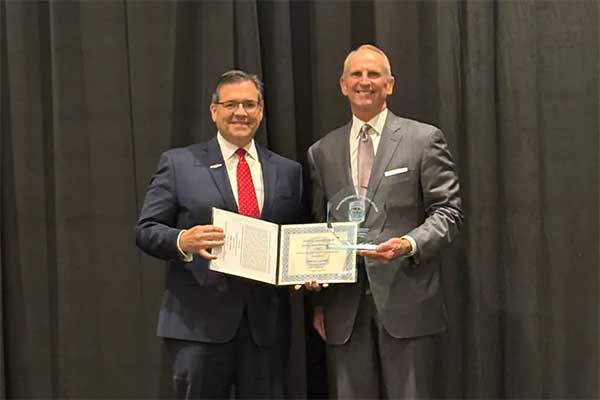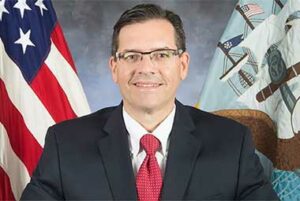MIE Alum Receives Distinguished Civilian Award

Mechanical engineering alum Donald Hoffer was awarded the Distinguished Civilian Award, given annually to a civilian who made significant contributions to the work of the U.S. Submarine Force. In his 37-year career with the Department of the Navy, Hoffer worked on several significant projects, including the restoration of the submersible Alvin.
This article originally appeared on Northeastern Global News. It was published by Cynthia McCormick Hibbert. Main photo: Donald L. Hoffer, left, receives the Distinguished Civilian Award for contributions to the U.S. Submarine Force in a ceremony that also honored former President Jimmy Carter. Courtesy photo
Northeastern graduate honored for pioneering submarine technology and strategy for the US Navy
From small lightweight, unmanned vehicles to the 18,000 ton Ohio Class SSBN, submarines have been the life’s work of Northeastern graduate Donald L. Hoffer.
On Thursday, Nov. 14, the Naval Submarine League honored Hoffer’s 37-year career with the Department of the Navy with the Distinguished Civilian Award, given annually to a civilian whose work has been of significant importance to the U.S. Submarine Force.
“The submarine force is the warfare arm that operates all of our submarines for the United States: attack submarines, ballistic submarines, search and rescue submersibles,” he says.
The undersea vessels, especially those crewed by humans, are “one of the more complex systems in the world,” says Hoffer, who graduated from Northeastern with a degree in mechanical engineering.
“You have life support systems, propulsion systems and a nuclear reactor for energy. Designs must deal with the pressures of the ocean,” he says. “It’s amazing technology. As an engineer, that has always been very interesting.”
Hoffer, who retired from the Department of the Navy in 2021, spent his last seven years of service with the Navy’s Fleet Forces Command in Norfolk, Virginia.
As executive director, Hoffer played a leadership role in building facilities, training crews, getting submarines ready for deployment and advising the military commander of the fleet on the future of undersea warfare.
Collaboration and strategy
The Naval Submarine League said Hoffer’s emphasis on collaboration and strategy has led to a resurgence in undersea warfare capabilities at a time when other nations are vying to control the watery depths.
At the time of his graduation from Northeastern, submarines were not exactly on Hoffer’s radar.
Commuting from his parents’ home in Waltham for all but one semester, Hoffer had co-ops with the U.S. Army and defense contractor Raytheon.
“That was really beneficial from an engineering standpoint,” Hoffer says about the experiential education. “I’m that kind of learner. It was a great advantage for me.”

Donald L. Hoffer graduated Northeastern with a degree in mechanical engineering. He spent 37 years with the U.S. Navy as a civilian employee specializing in submersibles. Courtesy photo
The son of the Coast Guard commander in Boston, Hoffer was recruited by the U.S. Department of the Navy to work as a civilian employee after graduating from Northeastern.
Among the opportunities available was an engineer-in-training program that had him working at the Portsmouth Naval Shipyard on a submarine under repair and then going to Navy headquarters at the Pentagon in Washington, D.C.
“I ended up getting hired into what is called the deep submergence program,” Hoffer says.
Working on the Alvin
“I spent a lot of my career working in deep ocean submersibles, including submarine rescue. One of the jobs I did, back in 2012, was help the National Science Foundation get the manned submersible Alvin back into service.”
Alvin is best known as the first submersible to take people—Woods Hole Oceanographic Institution scientist Robert Ballard and two companions—to the wreckage of the Titanic in 1986.
“As a Northeastern mechanical engineering student, I visited Wood Hole with the American Society of Mechanical Engineers while the search for Titanic was underway. I was fascinated by the submersible’s design and surprised by the announcement of the Titanic discovery shortly thereafter,” Hoffer says.
“Years later I would work with some of the same engineers as they upgraded Alvin.”
The NSF funds maintenance and operations at Woods Hole on the Alvin, which can dive to ocean depths of four miles. The Navy supports engineering work and provides safety certification.
Read Full Story at Northeastern Global News